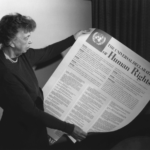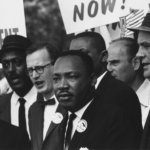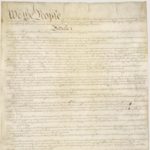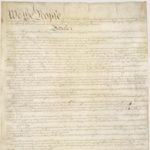When most people think of the Civil Rights Movement in America, they think of Martin Luther King, Jr. delivering his “I Have a Dream” speech on the steps of the Lincoln Memorial in 1963 and receiving the Nobel Peace Prize the following year. But “the Movement” achieved its greatest results — the 1964 Civil Rights Act and the 1965 Voting Rights Act — due to the competing strategies and agendas of diverse individuals. Even black Americans, the primary beneficiaries of this landmark legislation, did not agree on the tactics that should be used to secure the equal protection of their rights. This unit presents the views of several important black leaders who shaped the debate over how to achieve freedom and equality in a nation that had long denied a portion of the American citizenry the full protection of their rights.
Modern Day Slavery: Human Trafficking
Students will learn about human trafficking in the United States and read a short profile of human trafficking survivors as they think about the human rights that are violated in this modern form of slavery.
Teach Human Rights: Lesson Plans & Resources

The historical struggle for human rights is something that affects us, our children, and future generations as we fight for equity and inclusion in an increasingly torn society. It can also be difficult to speak with students about sensitive subjects, which is why this Share My Lesson collection provides expertly curated lesson plans, resources, and activities that define these rights, develop a global awareness, and teach how we can all make a difference when we act together.
March on Washington: Lesson Plans & Resources

On August 28, 1963, approximately 250,000 people participated in the March on Washington for Jobs and Freedom, which is considered to be one of the largest peaceful political rallies for human rights in history. Among other events, the march participants gathered at the Lincoln Memorial to hear Martin Luther King Jr. deliver his iconic “I Have a Dream” speech. Many consider The Great March on Washington to be the event that encouraged the passage of the Civil Rights Act of 1964 and the Voting Rights Act of 1965. The Share My Lesson team has created this collection of free lessons and classroom materials to help middle and high school educators teach their students about this historic event.
Creation of the Bill of Rights: “Retouching the Canvas”

This lesson will focus on the arguments either for or against the addition of a Bill of Rights between 1787 and 1789. By examining the views of prominent Americans in original documents, students will see that the issue at the heart of the debate was whether a Bill of Rights was necessary to secure and fulfill the objects of the American Revolution and the principles of the Declaration of Independence. Students will also gain an understanding of the origins of the Bill of Rights and how it came to be part of what Thomas Jefferson called “the American mind,” as well as a greater awareness of the difficulties that proponents had to overcome in order to add the first ten Amendments to the Constitution.
The Rule of Law in Your Life
Rule of law is a principle under which all persons, institutions, and entities are accountable to laws that are: publicly promulgated, equally enforced, independently adjudicated, and consistent with international human rights principles. The Administrative Office of the U.S. Courts has created this resource to help your students understand rule of law with an overview of the topic; opening discussion questions; relevant landmark case summaries; and discussion questions to check for understanding. In a Court Shorts video, nine federal judges explain how fair and consistent adherence to the law protects our rights and well-being in everyday situations.
Freedom of Speech
In this lesson, students analyze a photo of Robert Kennedy speaking outside the U.S. Department of Justice on June 14, 1963, and use it to discuss freedom of speech as a constitutional right in the United States, and human rights around the world.
The First Amendment: What’s Fair in a Free Country?

Young people have a profound sense of the importance of fairness. “It’s not fair” is often used as a one-size-fits-all argument when a child feels victimized. In situations where the child has an interest in protecting his or her actions, “It’s a free country!” is often the argument of choice. On the other hand, children are very sensitive about speech and policies they consider to have a negative effect on their well-being.
Balancing rights and responsibilities is difficult, even for the Supreme Court. This lesson demonstrates to students that doctrine of freedom of speech and its proper application is an ongoing process.
Habeas Corpus: The Guantanamo Cases
One of our oldest human rights, habeas corpus safeguards individual freedom by preventing unlawful or arbitrary imprisonment. This documentary examines habeas corpus and the separation of powers in the aftermath of the 9/11 attacks as the Supreme Court tried to strike a balance between the president’s duty to protect the nation and the constitutional protection of civil liberties in four major Guantanamo Bay cases: Hamdi v. Rumsfeld, Rasul v. Bush, Hamdan v. Rumsfeld and Boumediene v. Bush.
Closed captions available in English and Spanish.
I Have a Dream: Celebrating the Vision of Martin Luther King, Jr.

EDSITEment feature highlighting resources, activities, and lesson plans to help teachers, students, parents, and caregivers understand the impact Dr. King had — and continues to have — upon our country and the global efforts towards peace and civil rights.
On the third Monday of January, Americans celebrate the life and achievement of one of our most respected citizens — Martin Luther King, Jr. Dr. King was a leading force in the drive for civil rights in the United States, and he showed through words and actions that non-violent, persistent activism can achieve tremendous results by appealing to the moral conscience of Americans.